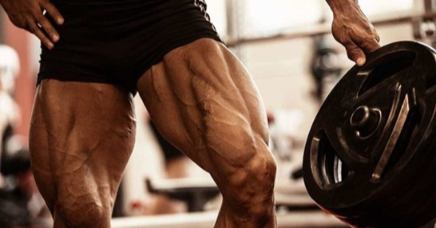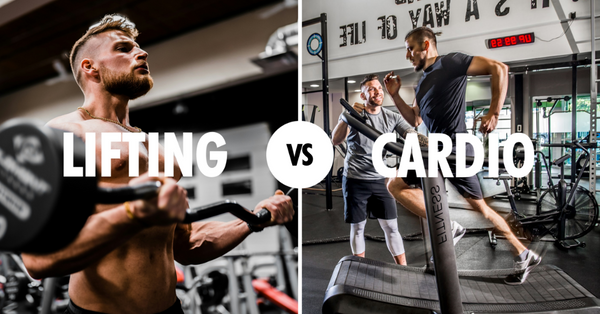The Fastest, Most Painful Way to Build Muscle You've Ever Tried

"You Want me to do What??" - a.k.a. BFR Training
Before I explain how you can start using this game-changing performance enhancement technique, I want to first ask you to keep an open mind. The pic above is not photoshopped and the athlete is natural (although Untapped may have been taken prior to training). With a high tolerance for pain, and a willingness to endure some odd looks in the gym, these results are realistic and attainable.
Look, I know this type of extreme-looking exercise might appear strange or even dangerous at first glance. Trust me, I felt the same way—until I dug deeper into the accumulating research validating this training method.
Then I tried it myself and with others and was blown away with the endless applications for busy men and women looking to build muscle while using lighter loads and sparing their joints.
My job is to discover the safest and most efficient ways to help you get physically better. And BFR is a technique that fits the bill. However, if you don’t want to try it, that’s cool too. You can still use all of the finishers outlined below without wrapping your limbs, though the results won’t be as good (just saying).
Now that I’ve gotten that out of the way, let me explain how you can start unlocking these new gainz. Get ready for the most epic muscle pumps of your life!

Blood Flow Restriction Training 101
To understand how BFR works, it’s important to do a quick debriefing on how your circulatory system (also called vascular or cardiovascular system) works. Your arteries are blood vessels that carry oxygenated blood away from your heart to your body. Your veins are blood vessels that carry mostly deoxygenated blood from the body back to the heart.
The goal of blood flow restriction training is to restrict venous return while still allowing arterial flow by strategically wrapping the topmost portion of your limbs. By restricting the veins and not the arteries, blood can keep pooling into a working muscle and it stays trapped there. It’s like filling a water balloon to max capacity (without it popping, of course).
By bringing in all of that blood to the working muscles without letting it leave, a couple key things happen.
One, you get a crazy pump. Seriously, your muscles become supersized. The theory is that this leads to cellular swelling which shocks the muscles into new growth.
Two, it’s gonna burn like hell. Your muscles quickly become deprived of oxygen and can’t get rid of accumulating waste materials, creating a lot of metabolic stress and acidosis -- which new research suggests is extremely anabolic and can even boost testosterone. Metabolic stress is one of the three major mechanisms of muscle growth and should not be overlooked. Prepare to be shocked at how quickly the pain train arrives, even with very light weights.

But the gains follow. Take it from Dr. Brad Schoenfeld, a regular Men’s Health contributor and one of the leading authorities on hypertrophy (the scientific term for muscle growth).
In his book Science and Development of Muscle Hypertrophy, he says: “The prevailing body of literature shows that BFR training stimulates anabolic signaling and muscle protein synthesis and markedly increases muscle growth despite using loads often considered too low to promote significant hypertrophy.”
Brad goes on further, saying that “it has been speculated that metabolic stress is the driving force behind BFR-induced muscle hypertrophy.”
Another really cool thing that happens with BFR is since your oxygen-dependent slow-twitch fibers fatigue way faster than normal, you have to quickly start tapping into your fast-twitch muscle fibers, which have the biggest potential for growth.
What’s crazy about this is your fast-twitch fibers typically don’t get hit unless you’re using heavy loads or moderately heavy loads performed explosively. But BFR allows you to go fast-twitch with loads less than 50 percent of your one-rep max. In fact, one study from the Journal of Applied Physiology showed increased muscle cross-sectional area with BFR training using loads as light as 20 percent of one-rep max. Take a second and do the math to appreciate how incredible that is. You might find yourself curling dumbbells as light as 10 pounds, while fighting harder, and gaining more, than you ever have in your life.
What this means for you is that with BFR you can use lighter loads to build muscle while sparing your joints from heavy loading and without overly fatiguing your central nervous system. It’s also important to note that research has shown the gains aren’t just for the arms and legs below the wraps but also for adjacent muscle groups above the wraps.
How to Wrap for BFR Training
There are some high-end pressure cuffs that can be used to wrap your limbs for BFR, but any wraps will work – even those Velcro wrist wraps you probably already have. Some people use ace bandages or knee/elbow wraps. Others use run-of-the-mill hospital tourniquets.
For the upper body, wrap it just below the shoulder at the top of upper arm so that the wrap is nestling into your armpit.

For the lower body, wrap just below the gluteal fold from the back and just below the hip flexor from the front (Tip: Do upper or lower, not both at the same time).

For both the upper and lower body, you want to wrap at about a 7 out of 10 on the tightness scale (10 being as tight as possible).
You shouldn’t feel any numbness or tingling sensations. If you do, that means you wrapped it too tight. Wrapping it too tight will restrict arterial flow and prevent blood from pooling in the muscle, so it defeats the purpose. When in doubt, wrap on the looser side of the spectrum, especially in the beginning.

How do you know if you wrapped it right? If you get the best muscle pump of your life!
Remember, if it feels sketchy just take the wraps off and re-wrap a little bit looser. There’s a bit of a learning curve in the beginning so don’t put too much pressure on yourself to nail it on the first try.
How to Use BFR Training to Build Muscle
The key to effective BFR training is using light loads (40 to 50 percent of your one-rep max or less), high reps (20 to 30 reps or more), and short rest periods (30 seconds or less). If you can’t get at least 20 reps, the weight’s probably too heavy. This is no time to “ego lift”. BFR training is all about high reps, quality contraction, and the baddest burn of your life.
It’s also important to note that BFR doesn’t replace your regular training—it just enhances it. Here are my three favorite ways to implement BFR training:
- BFR Finishers
After performing your main workout, hit a BFR finisher.
If you performed an upper-body workout, hit an upper-body BFR finisher. If you’ve just completed a lower-body workout, hit a lower-body BFR finisher. If you do total-body sessions, hit one for both the upper and lower body.
I’ve provided four finishers for both the upper and lower body below to get you started. But the options are endless!
- Extra Training Volume and Frequency
BFR is a great way to increase training volume (how much work you do) and training frequency (how often you train) without impairing your recovery.
For example, to bump up your training volume, if you did 3 regular sets of an exercise with heavier loads, try adding in an extra couple sets of BFR training for the same movement pattern or muscle group with a lighter load for higher reps and shorter rest periods between sets.
To bump up your training frequency, do any of the fast finishers outlined below on what is typically an “off-day.”
- Active Recovery and Deloading
Because BFR training requires using lighter loads, it’s significantly easier to recover from than heavier training. This makes it a great method to employ on days you’re feeling worn down but still want to train.
It’s also great to use if you incorporate frequent deloads—or periods of decreased loading or training volume—into your training schedule.
It’s worth mentioning that BFR is being used with remarkable success in rehab settings, particularly with wounded warriors. Being able to work and grow atrophied muscles after an injury or surgery with lighter loads is truly a joint-sparing feature unique to BFR training. As always, consult your physician or physical therapist to see if BFR training is right for you in these circumstances.
4 Great Upper Body Workouts
Upper-Body BFR Workout #1
Perform the following exercises in the order shown for the prescribed amount of time.
Seated biceps curl, 30 seconds
Overhead triceps extension, 30 seconds
That’s 1 round. Do 5 rounds for 5 minutes of continuous work.
Upper-Body BFR Workout #2
Perform the dumbbell triple crush complex (hammer curl to overhead press to overhead triceps extension) for 2 minutes. Rest 30 seconds.
That’s 1 round. Repeat for 2 total rounds.
Upper-Body BFR Workout #3
Perform the single-arm overhead press for 20 seconds. Then hold the top of the exercise for 10 seconds. Switch sides and repeat.
That’s 1 round. Do 5 rounds
for 5 minutes of continuous work.
(Hold a dumbbell in the non-working hand at shoulder level so you can immediately switch sides.)
Upper-Body BFR Workout #4
Perform the following exercises in the order shown for the prescribed amount of time, with no rest between exercises.
4 Great Lower Body BFR Workouts
Tip: Start with the upper body workouts first, until you get comfortable with a wrapping method, level of tightness, and how much pain you’re willing to handle. Once you’ve got the swing of things, begin adding these methods to your leg days and watch them blow up.
Lower-Body BFR Workout #1
Do split squats nonstop for 5 straight minutes, switching sides every 30 seconds.
Lower-Body BFR Workout #2
Do constant tension squats for 40 seconds (no lockout or pause at the top), then hold the bottom of the exercise for 20 seconds. Repeat for 5 minutes.
Lower-Body BFR Workout #3
Do shoulders-elevated hip thrusts for 20 seconds, then hold the top of the exercise for 10 seconds. Repeat for 5 minutes.
Lower-Body BFR Workout #4
Do extended-range of motion calf raises for 20 seconds, then hold the top of the exercise for 10 seconds. Repeat for 5 minutes.
Wrapping up (No pun intended!)
I hope I’ve inspired you to give BFR training a test drive. Personally, I credit it for increased muscle size, vascularity, and endurance over the past year and I continue to incorporate it into my training on a weekly basis.
Also in News

Upper Chest Won't Grow? It's the Bench Angle.
Your upper chest is flat because your incline bench angle is sabotaging you. One simple adjustment changes everything.

How to Build Legs When Gym's Busy AF
Gym's packed and you can't get a squat rack or a leg press? All you need is 1 heavy dumbbell and you'll never sweat a crowded gym again. Here's the play...

Lifting vs Cardio for Fat Loss: What’s REALLY Better?
Which one’s truly best for cutting body fat? Here’s what the latest science has to say. 💪🔥



